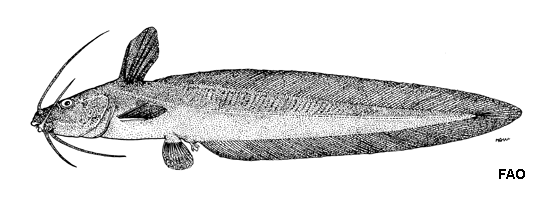| Plotosidae (Eeltail catfishes) |
| 134 cm TL (male/unsexed) |
|
reef-associated; brackish; marine; depth range 1 - 12 m |
| Indo-West Pacific: Indo-Australian Archipelago. |
|
Dorsal spines (total): 1-1; Dorsal soft rays (total): 104-115; Anal spines: 0-0; Anal soft rays: 90-100. Differs from Paraplotosus butleri in having a shorter dorsal fin and shorter nasal barbels, rounded pectoral fin shape, fewer upper procurrent caudal fin rays, and fewer gill rakers. Differs from P. muelleri in having a shorter dorsal fin and smaller eye (Ref. 31103). Color highly variable, ranging from pale grey or yellowish brown to dark brown, nearly blackish, sometimes with pronounced dark mottling; generally whitish on belly and ventral part of head; fins brown to blackish, frequently darker than body (Ref. 31103).
Description: Characterized by second dorsal fin immediately behind first dorsal fin and anterior to level of pelvic fin origin; depth of body about 7.0-8.0 in SL; head with four pairs of barbels; anterior nostrils tubular within folds of upper lip; gill membranes joined broadly across isthmus and attached anteriorly (Ref. 90102). |
| In tropical areas, inhabits clear and turbid coral reefs; usually found in areas with mixed sand, weed, and coral areas (Ref. 31103). May be seen resting on sand bottoms under ledges or around coral bommies (Ref. 31103). Adults solitarily or in small groups. Presumably nocturnal (Ref. 31103). Feeds on gastropod mollusks and crustaceans (Ref. 31103). Spines associated with anterior fins have potent venom (Ref. 9801). |
|
Least Concern (LC); Date assessed: 18 August 2023 Ref. (130435)
|
| venomous |
Source and more info: www.fishbase.org. For personal, classroom, and other internal use only. Not for publication.
